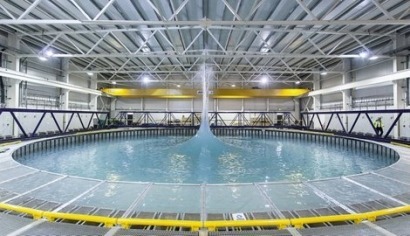
The FloWave is owned and operated by Edinburgh University and is based around a 30 metre circular concrete basin containing a 25 metre diameter, 5 metre deep wave and current tank with a capacity of 2.4 million litres of fresh water. It is ringed by 168 absorbing wave makers with an additional 28 submerged flow-drive units which can simultaneously and independently drive current across the tank in any direction. Current velocities can reach up to 1.6 metres per second.
A rising tank floor and 5 ton overhead crane enable quick and easy installation of individual devices or arrays. The tank’s circular shape means that waves and currents can act in any combination and in any relative direction across the large central volume, which is 17 metres in diameter and 2 metres deep.
The 168 wave-makers are optimised for 700mm, two second, waves and can create full-spectrum multi-directional waves as well as traditional monochromatic waves over a roughly circular test area of more than 200 square metres. Depending on the scale, this corresponds to full-scale seas of up to 28m waves, currents in excess of 12 knots, and a sea-area of approximately 2 square kilometres.
“Wave and tidal energy has an important part to play in our low carbon energy mix and the UK is already at the forefront of research and development in this innovative sector” said Ms Rudd. “It’s great to officially open and see first-hand FloWave’s new cutting-edge marine energy testing facility at the University of Edinburgh. Testing devices in realistic ocean conditions is essential for driving this industry forward to commercial success.”
FloWave Chief Executive Officer Stuart Brown added that the facility is unique in that it can create real sea conditions combining waves and tides for almost any location or sea state in the world. With the proper programming, the FloWave tank can accurately replicate at scale any point on the UK continental shelf. Researchers and industrial partners can use the facility to develop and refine prototype devices before building and testing them full-scale for deployment in near-identical conditions at sea.
“We believe FloWave will help accelerate learning, improve performance and reduce costs for developers, and we expect FloWave will be used to test wave and tidal energy converters, floating offshore wind platforms, and specialist vessels to install and maintain offshore projects” Mr Brown said.
The facility was conceived for cutting edge academic research into wave and tidal current interactions. Commercial developers can use the simulator to ensure their technologies and projects perform ‘right first time’ thereby de-risking their projects before beginning construction. More established developers can also use it to run model-scale tests on revised designs thereby incorporating experience gained from projects already in the water. It will also help demonstrator project and commercial array developers to validate CFD layout, micro-siting and energy yield predictions with physical modelling – before investing funds in projects.
For additional information:

